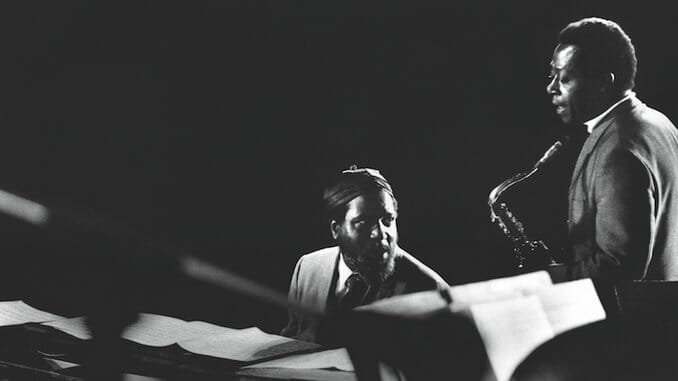Palo Alto: That Time When Thelonious Monk Played a High School
The unearthed recording of Thelonious Monk’s classic quartet oozes with bootleg charm
Photo by Veryl Oakland
Located in present-day Silicon Valley, the Bay Area city of Palo Alto was a most unlikely place to catch a Sunday-matinee performance by Thelonious Monk back in 1968. By that time, Monk’s jazz-giant stature had been firmly established, so it was a major coup that a plucky teenager named Danny Scher was able to snag Monk’s quartet for an appearance at his local high school. Palo Alto is the document of that performance, which is finally seeing the light of day after Scher, who’d forgotten that the school custodian recorded the show, found the tape in his attic some 15 years ago. At that point, he contacted Monk’s son, drummer T.S. Monk, who was surprised to discover that his father had even played a high school at any point in his much-heralded career.
The story behind Palo Alto, which could easily fill this review, oozes with charm and social context, both beautifully captured in liner notes that are worth the price of admission alone, even if you’ve watched the promotional mini-documentary released by the label. In that same promo clip, T.S. Monk surmises that his father’s quartet was so well-oiled by 1968 that “they could [have] set up in a phone booth and sound like the records.” Well, Palo Alto doesn’t quite sound like it was recorded in a phone booth—it would be worth hearing even if it had been—but listeners should know ahead of time that the fidelity level here falls into bootleg range.
Which is not to say that you can’t hear every instrument clearly. On the contrary—many, many acoustic nuances shine through: the greasy resonance as bassist Larry Gales scrapes his strings with a bow during his solo on a 13-minute version of “Well, You Needn’t” (with Monk himself humming along), the variety of timbres and colors as drummer Ben Riley’s toms pop and cymbals hiss, etc. Riley’s drums in particular swell to loud enough volume that they stress the microphones, which creates the illusion that the listener is seated near the drumset and, thus, up close and personal with the musicians onstage.
That said, the recording has a dry, boxed-in character that, for better or worse, defines the listening experience. In strictly psychoacoustic terms, the band feels disembodied from the audience, from the room, and from itself. For one, the quartet itself is literally split up, with Riley and tenor saxophonist Charlie Rouse hard-panned to one side of the stereo field and Monk panned to the other along with Gales. Meanwhile, the audience’s loud but muffled applause never integrates with the music, much in the same way we’d compare to a modern-era soundboard recording. So it’s difficult to get any sense of room ambience, and, as a result, it’s also difficult to connect with the band’s energy.
Then again, we’re talking about some of the most elegant musical compositions ever written here, and there is a certain appeal to hearing them this way. When you listen to Palo Alto, you can almost imagine that you went up to the attic yourself and found it in a box with some of your other belongings. You can hear Monk’s piano bench creaking on his unaccompanied rendition of the Jimmy McHugh/Dorothy Fields standard “Don’t Blame Me,” but the added sound actually stays in time with his playing. When he introduces the piece with chords, the emotion and spirit both come across unimpeded, as does his unique ability to combine solemn tones with whimsy. And no recording limitations could have dulled the sparkle when he punctuates those chords with rapidly descending right-hand runs.
-

-

-

-

-

-

-

-

-

-

-

-

-

-

-

-

-

-

-

-

-

-

-

-

-

-

-

-

-

-

-

-

-

-

-

-

-

-

-

-








































